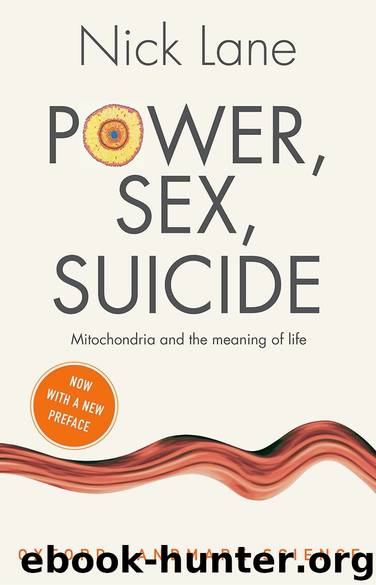Power, Sex, Suicide by Lane Nick;

Author:Lane, Nick;
Language: eng
Format: epub
Publisher: Oxford University Press
Published: 2018-09-20T00:00:00+00:00
1 How do we reconcile Max Rubner’s exponent of 2/3 with Max Kleiber’s 3/4? The usual answer is that within species the metabolic rate does indeed vary with 2/3, and the 3/4 exponent only becomes apparent when we compare different species.
2 In fact they make a specific prediction based on this. The presence of a network obliges individual mitochondria to operate more slowly than they would if they were relieved from the constraints of the network. When grown in culture, cells have a lavish supply of nutrients delivered to them directly from the surrounding medium: there is no network, so cells can’t be constrained by it. If unconstrained, the metabolic rate should rise. On this basis, West, Woodruff, and Brown calculate that cultured mammalian cells should become more meta- bolically active in culture, and they predict that cells should contain approximately 5000 mitochondria after several generations in culture, each with about 3000 respiratory complexes. These numbers seem wrong. Mammalian cells tend to adapt to culture by losing mitochondria, becoming instead dependent on fermentation to provide energy, giving off the waste product lactate. Accumulation of lactate is known to impede the growth of mammalian cell cultures. As to the number of respiratory complexes in a single mitochondrion, most estimates are in the order of 30 000, not 3000. Far from ‘agreeing with observation’, West, Woodruff, and Brown’s estimate appears to be an order of magnitude out.
3 Another re-analysis, published in 2003 by Craig White and Roger Seymour, at the University of Adelaide, came to a similar conclusion.
Download
This site does not store any files on its server. We only index and link to content provided by other sites. Please contact the content providers to delete copyright contents if any and email us, we'll remove relevant links or contents immediately.
| Cell Biology | Developmental Biology |
| Entomology | Marine Biology |
| Microbiology | Molecular Biology |
| Biostatistics |
Sapiens: A Brief History of Humankind by Yuval Noah Harari(13979)
The Tidewater Tales by John Barth(12391)
Mastermind: How to Think Like Sherlock Holmes by Maria Konnikova(6931)
Do No Harm Stories of Life, Death and Brain Surgery by Henry Marsh(6683)
The Thirst by Nesbo Jo(6432)
Why We Sleep: Unlocking the Power of Sleep and Dreams by Matthew Walker(6347)
Life 3.0: Being Human in the Age of Artificial Intelligence by Tegmark Max(5182)
Sapiens by Yuval Noah Harari(5117)
The Longevity Diet by Valter Longo(4856)
The Body: A Guide for Occupants by Bill Bryson(4577)
The Rules Do Not Apply by Ariel Levy(4520)
The Immortal Life of Henrietta Lacks by Rebecca Skloot(4248)
Why We Sleep by Matthew Walker(4190)
Animal Frequency by Melissa Alvarez(4147)
Yoga Anatomy by Kaminoff Leslie(4100)
The Hacking of the American Mind by Robert H. Lustig(4080)
All Creatures Great and Small by James Herriot(3980)
Barron's AP Biology by Goldberg M.S. Deborah T(3941)
Double Down (Diary of a Wimpy Kid Book 11) by Jeff Kinney(3920)
